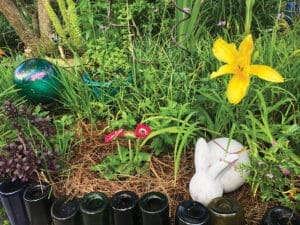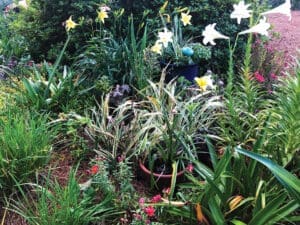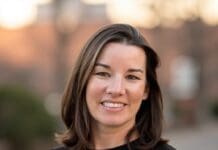By Marta Rose-Thorpe
 Our honeybees are critical. Einstein said if we lose our honeybees, we’re doomed as a planet. Doomed? Yes, doomed! Honeybees are vital to our pollination. I started taking more of an interest in bee and butterfly gardens when I saw a few alongside Beck Avenue in Historic St. Andrews one day. Then my friend Allison Smith, wellness guru, landscaping professional, and horticulturist (more on Allison in just a bit), explained more to me… She told me not only what plants attract the bees and the butterflies, but also how to make your own garden at home. Allison has more than 60 plants squeezed into a small area in her yard, all blooming at different times to attract bees and butterflies.
Our honeybees are critical. Einstein said if we lose our honeybees, we’re doomed as a planet. Doomed? Yes, doomed! Honeybees are vital to our pollination. I started taking more of an interest in bee and butterfly gardens when I saw a few alongside Beck Avenue in Historic St. Andrews one day. Then my friend Allison Smith, wellness guru, landscaping professional, and horticulturist (more on Allison in just a bit), explained more to me… She told me not only what plants attract the bees and the butterflies, but also how to make your own garden at home. Allison has more than 60 plants squeezed into a small area in her yard, all blooming at different times to attract bees and butterflies.
 She says it’s easy: just plant or put out containers of plants that will attract bees and butterflies. Butterflies drink nectar, which comes from flowers. Some great starter (easy to grow) plants are salvias, daylilies, pentas, and zinnias. The vitex tree, crepe myrtle, and any kind of flower attract honeybees, and certain plants help attract certain butterflies to lay their eggs. For example, the black swallowtail only lays her eggs on limited types of plants: parsley, dill, and fennel. This time of year, it’s hot, but you can put parsley in your yard. As the summer goes by you may notice the tiny caterpillars which eat like crazy… then they crawl, hang, and hatch into beautiful butterflies. Some live for days, some for weeks – it depends on the species. Another way to attract bees and butterflies is to encourage them with somewhere to drink. Take a birdbath or tray, salad bowl or plate… add little pebbles or rocks and just a bit of water, and they can drink from it. Cut up orange slices and lay them out on a tray in the sun, which will attract bees and butterflies.
She says it’s easy: just plant or put out containers of plants that will attract bees and butterflies. Butterflies drink nectar, which comes from flowers. Some great starter (easy to grow) plants are salvias, daylilies, pentas, and zinnias. The vitex tree, crepe myrtle, and any kind of flower attract honeybees, and certain plants help attract certain butterflies to lay their eggs. For example, the black swallowtail only lays her eggs on limited types of plants: parsley, dill, and fennel. This time of year, it’s hot, but you can put parsley in your yard. As the summer goes by you may notice the tiny caterpillars which eat like crazy… then they crawl, hang, and hatch into beautiful butterflies. Some live for days, some for weeks – it depends on the species. Another way to attract bees and butterflies is to encourage them with somewhere to drink. Take a birdbath or tray, salad bowl or plate… add little pebbles or rocks and just a bit of water, and they can drink from it. Cut up orange slices and lay them out on a tray in the sun, which will attract bees and butterflies.
Allison also found that you can use essential oils to attract the bees and the butterflies; just place drops on statues and yard art and put cotton balls doused in oil in and around your yard. The bees and butterflies like the smells. Honeybees will travel up to a mile to get to good nectar. They have scouts who will travel to find the nectar. Then, the scouts go back to the hive and do a dance, showing/telling the other bees how to get to your yard. It’s amazing! For further research on creating bee and butterfly gardens, Allison suggests a visit to gardenswithwings.com. “Many people are Vitamin D deficient,” she says. “Gardening is very therapeutic – it gets you outside and in the fresh air and sunshine. It also allows us to help nature, especially bees and butterflies.”
So how does Allison know so much about creating bee and butterfly gardens? Her family roots go back to plants, trees, and nature, where her family owned a nursery and landscaping business in Somerville, AL, a little town just outside of Huntsville. “My dad got into design work and planting perennial gardens – he loved flower beds, that was his niche,” she remembers. “His favorite saying was, ‘Let’s take some grass out and put a bed there!’” In college, Allison pursued a degree in Landscape Design, Installation & Maintenance at Auburn University. “We were taught how to design and install a yard, and then maintain it,” she explains. Allison loved all her classes and was the tenth female at Auburn with that major. “There were only nine females in my major at that time – so I finally put them in double digits!”
After receiving her BS degree in Ornamental Horticulture, she interned at Disney World’s Summer Horticultural Program. Her first job out of college was maintaining the gardens for a large resort close to Disney, but after two years her parents convinced her to move back to Somerville and work at the family business. Of course, going from Orlando back to rural Alabama “was not fun,” and when her sister offered Allison a job opening her and her husband’s new restaurant in Panama City Beach, Florida – Latitudes on Front Beach Road – she accepted the position and moved to the beach in 2000. Currently, Allison is Vice President of Business Development for Herbefex, a local company specializing in residential and commercial landscaping.
Four years ago, Allison discovered Young Living. “I had heard of Young Living strictly as a company that sold essential oils,” she shares. “Getting involved as a customer led me to the path of going chemical-free in my home.” She learned more about ingredients that are in products, which in turn sent her on an educational search. “My theory is, if I don’t know about this, I’ll bet other people don’t know about this either. Everything on our shelves has not been tested and vetted. In 1976 the Federal Government passed a chemical law, and everything already in use was grandfathered in.”
The stats are staggering. “The average American female will put 88 chemicals on her body before breakfast,” she shares. “Think about your morning routine. Shower soap, shampoo, body lotion, makeup, deodorant, haircare products, perfume. The European Union has banned over 1300 ingredients – America has not hit 20 yet. Europe is paying closer attention to side effects – we are not there yet.” For more information, email Allison at alliepcb@yahoo.com and she’ll send you The Dirty Dozen: Twelve of the worst chemical culprits found in everyday products.





















































